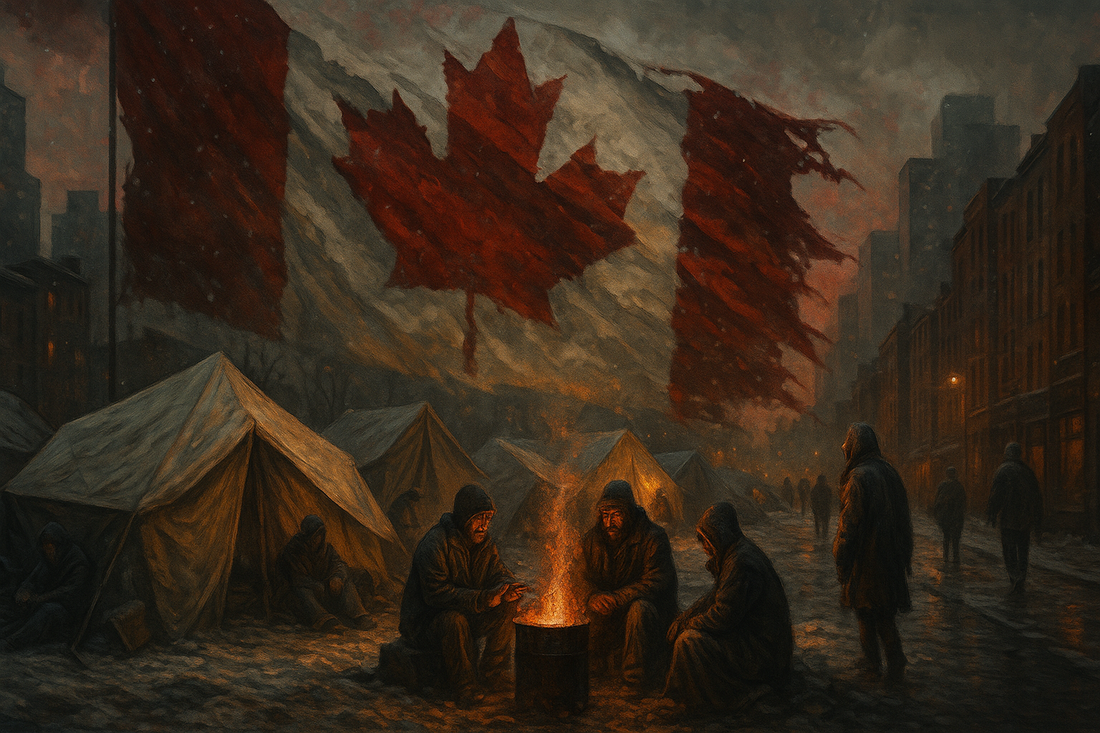
I Asked AI to Analyze Ontario’s Homeless Crisis — What It Found in Toronto, London, and Barrie Will Break You
Share
When I fed five years of Ontario’s homeless and drug data into an AI model, I expected numbers. What came back were warnings — red flags in flashing lights.
From Toronto’s overflowing shelters, to London’s tent cities, to Barrie’s emergency declaration, the data painted a chilling picture: our province is collapsing in slow motion, and the streets are where it shows first.
Toronto: The Meltdown of a Metropolis
In 2013, Toronto counted just over 5,000 people without homes.
By 2021, it was 7,300.
By 2024 — 15,418.
That’s not just a spike. That’s a city within a city, living in tents, stairwells, and alleyways. Over 1,600 people sleep outside every night, many battling addictions and mental health struggles that the system no longer has capacity to treat.
Half the people the city surveyed said they were homeless because rent simply became unaffordable. The other half cited mental illness or addiction. Both are true.
In the wealthiest city in Canada, thousands now die decades younger than their neighbors. The median age of death for a homeless man in Toronto is 50. For women? Thirty-six.
Drug poisoning — often fentanyl — is the top killer. Not cancer. Not heart disease. Toxic drugs.
London: The City of Tents and Forgotten Souls
Drive down Adelaide or Hamilton Road and you’ll see it — blue tarps, grocery carts, the smell of wood smoke in the winter air.
That’s not neglect anymore. That’s normalization.
In 2018, London counted just over 400 people without housing. By 2023, that number was over 2,000 — a fivefold increase. About 600 of them are what outreach workers call “high acuity,” meaning they live with complex trauma, illness, and addiction.
Encampments have tripled. Waitlists for affordable housing stretch into years. Over 7,000 households are waiting for a unit that may never come.
And inside shelters, meth-induced psychosis and fentanyl overdoses have become part of the night shift. Front-line workers administer naloxone like clockwork. The lucky ones wake up.
Barrie: The Tipping Point
Barrie’s crisis exploded so fast the mayor had no choice but to call it what it is — a state of emergency.
City staff found 20 active encampment sites across public parks. In some tents, police found crossbows, guns, and used needles. In nearby streams, E. coli levels were five times higher than normal because there were no toilets, no sanitation, no place to go.
Barrie’s emergency wasn’t just about homelessness. It was about safety — for everyone.
“Enough is enough,” said the mayor, after tent fires, overdoses, and violence made headlines.
But those words ring hollow when the root issue is province-wide rot.
Thunder Bay: The North Bleeds Quietly
Few talk about Thunder Bay, but they should. With a population of barely 110,000, it has one of the highest overdose death rates in Ontario — roughly 69 deaths per 100,000 residents.
Over 68% of the city’s homeless are Indigenous, living with layers of trauma that reach back generations. Resources are thin. Winter kills some; fentanyl takes the rest.
When AI compared per-capita data, Thunder Bay wasn’t just in crisis — it was statistically worse than Toronto in mortality, overdose rate, and unsheltered homelessness.
The Drugs Behind the Numbers: Fentanyl and Meth
Fentanyl now kills about seven Ontarians every single day — that’s 2,600 people a year.
Crystal meth has become the province’s quiet co-pilot in chaos.
Meth-related ER visits are up 700% since 2014. Stimulant-induced psychosis has filled hospitals, jails, and shelters. And now, fentanyl is showing up in meth itself — turning users into unknowing victims of a poisoned supply.
As one paramedic in Toronto put it:
“We used to revive one person a night. Now it’s six before breakfast.”
The Cost: Human, Moral, and National
What’s happening in Ontario isn’t just a drug crisis. It’s a collapse of the social contract.
Emergency rooms, jails, and shelters have become the default housing program. Outreach workers are now battlefield medics.
If nothing changes — if Ontario doesn’t declare a formal state of emergency — projections show 30,000 homeless in Toronto by 2030, and overdose deaths remaining three times higher than pre-2020.
That’s not sustainable. That’s surrender.
The Future We’re Building by Doing Nothing
AI projections modeled three paths for Ontario:
-
Status Quo: 2,000+ overdose deaths per year, climbing homelessness, rising public fear.
-
Slow Reform: Slight improvements by 2030, but high death toll continues.
-
Emergency Response: Massive investment in housing, treatment, and harm reduction could cut deaths by half within 5 years.
The math is simple: without intervention, Ontario will normalize death and despair as background noise.
The only real question is whether we’ll still recognize our cities when it’s done.
Final Word: The True North Is Fading
Northern Valor was built on grit, faith, and truth. But this — this is the kind of quiet war that destroys nations from the inside.
If we can mobilize billions for green energy, foreign aid, and global projects, we can damn well mobilize for our own citizens freezing and dying in the streets of Ontario.
AI doesn’t have feelings.
But after seeing what it found, I do.
And I’m angry.
Because this isn’t an algorithmic failure — it’s a moral one.
And history won’t forgive us for letting the True North fall apart on our watch.
